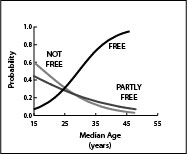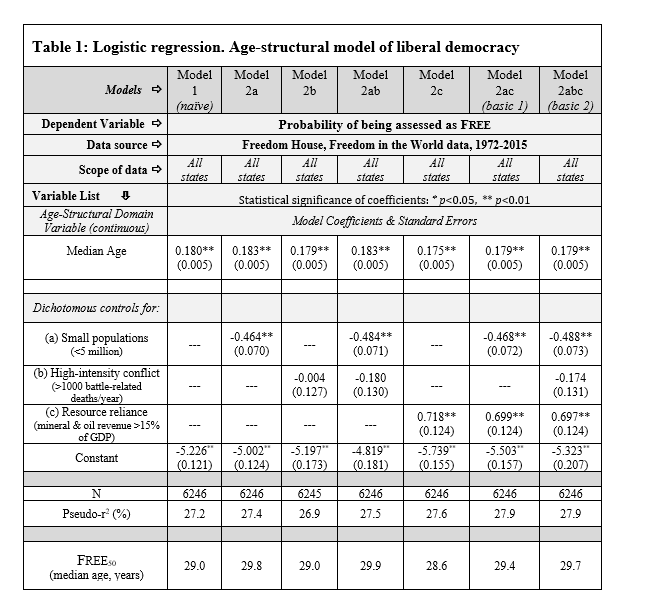 State Behavior in Age-structural Time
State Behavior in Age-structural Time
The most discussed breakthrough in international political theory over the past decade appears to be Nassim Taleb’s formulation of the “Black Swan hypothesis. Taleb argues that the dynamics of state behavior are so complex and hidden that political outcomes and their timing are generally impossible to forecast. Others (including myself) read Taleb’s thesis as an exhaustingly lengthy excuse–a disheartening admission that the endeavor of forecasting state political behavior is beyond the capacity of current social science. Taleb’s treatise follows on a study published by Philip Tetlock in 2005, which reported on a 15-year experiment that the author ran with the consent of a group of highly qualified political scientists. Tetlock found that when these seasoned academics chose among predicted futures based on current political theories and the full wealth of their experience, they could perform no better than the guessing average.

Table 1. Logistic regression statistical table for the age-structural model of liberal democracy (likelihood of being assessed as FREE in Freedom House’s annual survey of civil liberties and political rights).
Whereas political analysts expect political outcomes to be generated, over time, by the activities and evolving relationships of political actors, political demographers find that most states that have populations with similar age structures (distributions of residents, by age) behave similarly. Rather than evolving over time, these state behaviors appear to be timed by the movement of country-level populations through the age-structural transition–the position and pace of which has been called “age-structural time.” Thus, political demographers tend to analyze state behaviors over the course of the age-structural domain–an X axis measured in median age (a indicator of the maturity of a country’s age structure).
Why has this form of analysis yielded new insights? Over the past two decades, economic and political demographers have proposed and tested theories that identify demographic changes as key factors in a range of economic and political transitions (reviewed by Cincotta, 2012, and by Goldstone, 2012). Whether or not these are causally related, either directly or complexly, is a contentious topic that is the subject of debate among economic demographers and economists, and political demographers and political scientists.
The list of state-level effects that are associated with fertility decline and age-structural change is surprisingly long, and the effects are politically consequential. These country-level effects include: the onset of intrastate conflict (Möller, 1968; Mesquida and Weiner, 1999; Goldstone, 2002; Urdal, 2006; Cincotta and Leahy 2007); employment (Easterlin, 1968); women’s participation in the workforce (Bauer, 2001); democratization and democratic stability (Cincotta, 2008, 2009, 2013; Weber 2012; Cincotta and Doces, 2012; Dyson, 2013); the accumulation of government and household savings (Higgins and Williamson, 1997; Lee and Mason, 2011); economic development (Williamson, 2001; Bloom et al., 2002); societal investments in education (Lee and Mason, 2011); and the accumulation of public debt (Eberstadt and Groth, 2010; Lee and Mason, 2011).
For defense and foreign policy analysts, the implications of these findings are noteworthy. They indicate that, for a number political and economic transitions, modern states appear to perform more predictably when these variables are monitored as a response to changes in the configurations of their age-structure, than they do when monitored in chronological time. Therefore, analysts should expect to improve aspects of their analyses by shifting countries onto the age-structural time domain—an X-axis measured in years of median age (the age of the “middle person,” for whom 50 percent of the population is younger, and the other 50 percent is older).
For analysts tasked with early warning, shifting to age-structural time has a substantial advantage. Because UN demographers biennially generate demographic projections (demographic scenarios of the future) for each currently extant state, the future ceases to be a barrier to analysis. In other words, age-structural models that were originally fit to historic data—observations drawn from the demographic and political outcomes of countries that have already advanced through the age-structural transition—can statistically predict future trends by using projected (future) median ages as their inputs.
Unlike conventional historians and political scientists, analysts using age-structural methods need not be “stuck” in the chronological time domain. They can move back and forth, shifting from chronological time (the year) into age-structural time (the median age), in order to make a statistical prediction. And then they can re-transform their predictions, returning to chronological time—the domain in which intelligence consumers operate—to report their timed early warnings.
